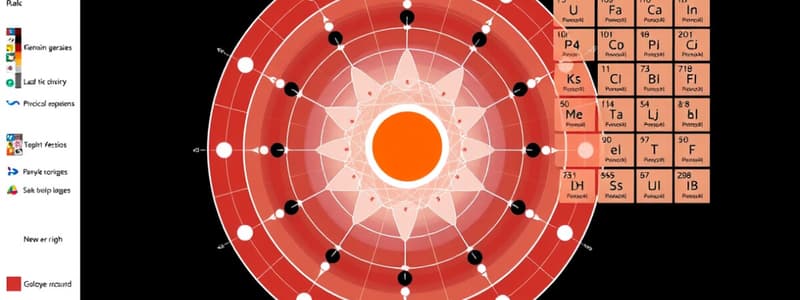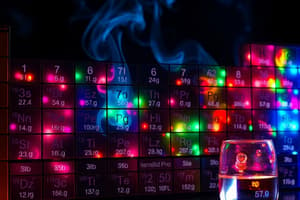Podcast
Questions and Answers
What happens to the ionic radius of sodium when it forms a cation?
What happens to the ionic radius of sodium when it forms a cation?
- It decreases due to loss of an energy level. (correct)
- It increases significantly.
- It becomes equal to the atomic radius.
- It remains unchanged.
How does the ionic radius of fluoride compare to its atomic radius?
How does the ionic radius of fluoride compare to its atomic radius?
- It is smaller due to a greater nuclear charge.
- It becomes one-third larger than the atomic radius.
- It is larger because it gains an electron. (correct)
- It does not change.
Why does the fluoride ion have a larger radius than the fluorine atom?
Why does the fluoride ion have a larger radius than the fluorine atom?
- It has gained additional protons.
- The loss of electrons reduces its size.
- Electron repulsion increases the cloud size. (correct)
- It has fewer energy levels than the atom.
What is the atomic radii a measure of?
What is the atomic radii a measure of?
What signifies the change in atomic radius for a sodium atom when it becomes a cation?
What signifies the change in atomic radius for a sodium atom when it becomes a cation?
How does the atomic radii change when moving down a group in the periodic table?
How does the atomic radii change when moving down a group in the periodic table?
Which statement correctly describes the ionic transformation of sodium and fluorine?
Which statement correctly describes the ionic transformation of sodium and fluorine?
What happens to atomic radii as you move from left to right across a period?
What happens to atomic radii as you move from left to right across a period?
Which element has the smallest atomic radii?
Which element has the smallest atomic radii?
Which of the following elements has the largest atomic radii?
Which of the following elements has the largest atomic radii?
Flashcards are hidden until you start studying
Study Notes
Atomic Radii
- Defined as the distance from the nucleus center to the outermost electron.
Trends in Atomic Radii
- Increases down a group/family due to the addition of extra energy levels (electron shells).
- Decreases from left to right across a period as increased proton count leads to stronger coulombic attraction, pulling electrons closer to the nucleus.
Element Characteristics
- Largest atomic radii: Francium (Fr) - Colored RED on the Periodic Table
- Smallest atomic radii: Helium (He) - Colored ORANGE on the Periodic Table
Order of Atomic Radii
-
Increasing Order:
- Calcium (Ca), Strontium (Sr), Barium (Ba)
- Nickel (Ni), Cobalt (Co), Iron (Fe)
-
Decreasing Order:
- Lithium (Li), Sodium (Na)
- Neon (Ne), Fluorine (F), Oxygen (O)
Ionic Radii
-
Sodium (Na) Atomic Structure:
- Sodium atom: Central "Na" with one ring of electrons.
- Sodium ion (Na+): Central "Na+" with one ring of electrons; the cation has a smaller radius due to the loss of an electron.
-
Fluorine (F) Atomic Structure:
- Fluorine atom: Central "F" with two rings of electrons.
- Fluoride ion (F-): Central "F-" with two rings of electrons; the anion has a larger radius because it gains an electron, leading to lower nuclear charge and increased electron repulsion.
Studying That Suits You
Use AI to generate personalized quizzes and flashcards to suit your learning preferences.




